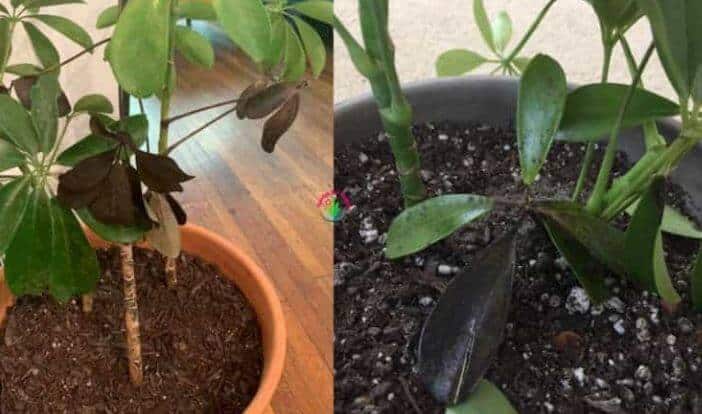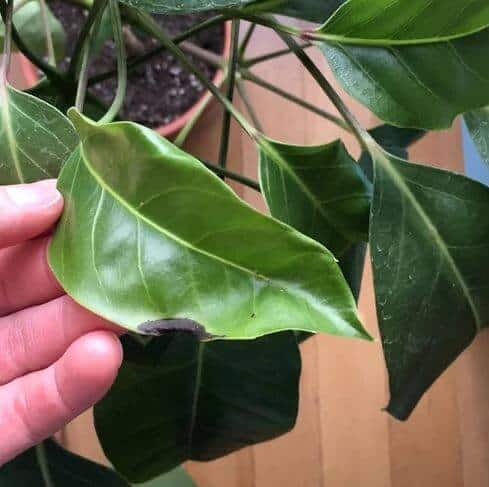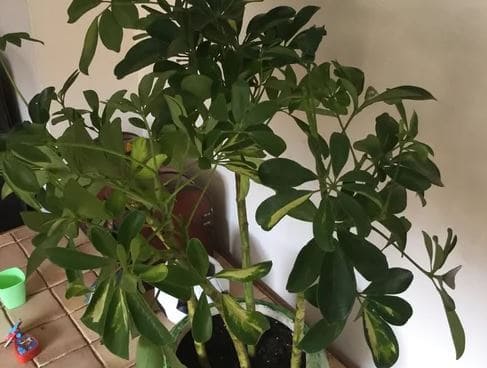Last Updated on May 26, 2023 by a Friendly Gardener
Popularly known as the Umbrella Plant, the Schefflera plant is an attractive and easy-to-care-for houseplant, although they make wonderful additions to outdoor gardens as well. Outdoors these plants can grow to be large trees.
Normally, a healthy Schefflera will have foliage that is a deep green hue but should the leaves turn black, your plant is communicating it has a problem.
Why Are My Schefflera’s Leaves Turning Black?

Unfortunately, there is more than one reason why this plant’s foliage may change color. Here are several of the most commonly found causes:
Bacterial Infection
Leaf Blight is probably the most common bacterial disease to afflict a Schefflera and appears as black spots on Schefflera leaves. These bacteria attack the plant’s foliage and will generally begin with small water spots on the foliage that slowly turn black causing the leaves to die.
To help your plant, remove any affected leaves and destroy them. A treatment with bactericide will also be effective in killing the infection.
Fungal Infection
Fungus is another culprit when it comes to Umbrella Plant leaves turning black. One of the most often-seen fungal infections to strike Schefflera plants is sooty mold. This fungus will grow on leaves and stems and generally is caused by pest infestations by mealybugs or aphids. These bugs secrete sticky honeydew which is the perfect growing substance for the mold. Leaves will begin to discolor, a black substance will appear and foliage will be stunted in growth.
Remove any pests and spray the Schefflera with insecticidal soap. You can also wipe the black mold substance from the leaves with a moist cloth.
Schefflera stems turning brown can also be an indication of an Alternaria Brown spot or a canker fungus. Alternaria brown spots can be treated with a fungicide if caught early whereas a canker fungus may be noticed once the plant is compromised. Try organic Neem oil which is a natural fungicide.
Feeding Issues

The Umbrella Plant is not a heavy feeder, so too much fertilization will damage your plant. Fertilizers that are high in nitrogen, or simply overfeeding your plant can cause foliage to turn black. You’ll be able to identify overfeeding as the cause if there is also a buildup of fertilizer on the soil bed surface.
If this is the cause, you will need to flush your plant with ample amounts of water to rid the soil of buildup. Reduce future fertilization considerably and make sure the fertilizer you use has low nitrogen content. It is sufficient to feed your Scheffler bimonthly during the growing season.
Overwatering the Umbrella Plant
Overwatering is a very common cause of umbrella plant leaves turning black and falling off. The Schefflera is a hardy plant that can resist a bit of drought, but they do not tolerate soggy soil or being left standing in water. If the soil bed is water-logged, the roots will not receive adequate oxygen. Leaves will turn black and begin to die. You may notice wilting and that stems turn soft.
To correct this problem, allow your plant’s soil bed to dry out. Do not water the plant further until the soil has dried out entirely. Then water the plant thoroughly and wait until the soil dries out again.
Underwatering the Umbrella Plant

Underwatering is also a common reason for Umbrella plant leaves turning black. While they can tolerate a bit of underwatering, they are sensitive to prolonged drought. Foliage will stress due to a lack of water. Foliage will begin to droop and may turn yellow, then brown, and then black. They will then drop. If the soil bed is overly dry to the touch, your plant will need a drink.
To resolve this problem, water your plant on a regular schedule. Ensure that the soil bed is evenly moist, and that the container has drainage holes for excess water. Plan on watering at least once every two weeks, but the frequency will depend on your climate, container, and soil type so you may need to water weekly.
Temperature Issues

Environmental temperature stress can cause Schefflera foliage to turn black. This is a tropical plant, so it prefers a warmer climate. When temperatures drop too much, leaves will begin to blacken. Temperature stress will be evident if leaves begin to blacken on the tips or around the edges.
To fix this problem, move your Schefflera to a warmer location. Ideally, room temperatures should measure between 65° and 90°F. Any temperature below 60°F will cause your plant to stress.
Pests
The Umbrella plant is susceptible to infestations of aphids, mealybugs, and spider mites. Schefflera leaves turning brown and falling off or turning black may be due to an infestation. These bugs are sap suckers and will remove moisture and nutrients from foliage. Insects or honeydew on leaves is a sign.
You can remove pests manually with a cotton ball soaked in rubbing alcohol. For more severe infestations, try organic Neem oil or insecticidal soaps.
Mineral or Salt Buildup
The buildup of salt or minerals in the soil bed can also cause Schefflera leaves to turn black. If you are using tap water, minerals will build up over time in the soil causing it to be toxic. This is especially true if the water is hard or has high mineral content. If foliage shows a white or yellow substance on the blackened leaves, it’s mineral buildup.
To begin with, to fix this problem, flush your plant’s soil bed with large amounts of water and allow it to drain. Switch to watering with distilled water, filtered water, or collected rainwater.
Excessive Sunlight Exposure
As tropical plants, the Schefflera needs sunlight, but exaggerated sun exposure can turn foliage black. Find a place with lots of bright indirect light. Excessive sunlight exposure will be apparent as leaves will turn yellow or a very pale green and black. Brown spots are also a symptom. If you don’t have a spot with indirect light, try a window with a sheer curtain.
Inadequate Sunlight

Too little sunlight can also cause the Umbrella plant’s leaves to turn brown or black. These plants will get leggy, developing long stems as they reach for the light.
Make sure your plant gets at least four hours of indirect sunlight daily. You can also use a grow light if the location is a low-light environment.
Root Rot
Root rot is the result of a fungus attacking the root system. Often root rot sets in when a plant is overwatered. The fungus can be found in the soil and enter the plant through wounds found in the roots. Once the fungus attacks the plant it will begin to kill it with foliage blackening. Roots will appear mushy and may emit a smell.
To attempt to save your plant, repot it. Remove the plant from its container, sterilize the pot, and prune off infected roots. Treat the root system with a fungicide. Replant the Schefflera in fresh potting soil.


